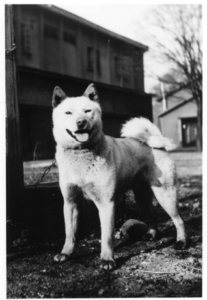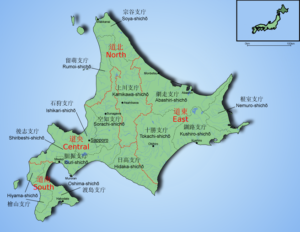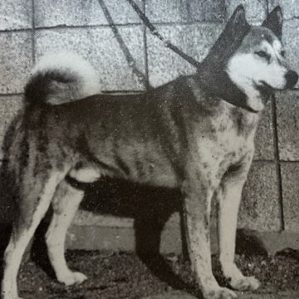- Humans Walk With Dogs
- Preface
- (Ⅰ)The role of dogs in Hokkaido, Japan
- (Ⅱ)Hokkaido native dogs; Hokkaido dogs [ or Ainu dogs] and Sakhalin dogs( or Karafuto inu).
- (Ⅲ)Hokkaido dogs ( or Ainu dogs)
- (Ⅳ)Preservation of Japanese native dogs as natural treasures .
- (Ⅴ)Hokkaido dog in current times
- (Ⅵ) Brief introduction of Ryukyu dog
Humans Walk With Dogs
# written by Sachiko Yamano, member of Hokkiaido dogs Preservation Association 山野幸子 一般社団法人 天然記念物北海道犬保存会会員, who worked with Japan International Cooperation Center (JICE) .
Preface
In my understanding, many dog lovers get satisfaction from living together with dogs as family members. They spend their daily lives with dogs when eating , sleeping, taking a walk and just sharing time doing nothing. At the same time, the excellent studies on Japanese native dogs have been achieved mostly by some dog lovers who were not scholars nor researchers on dogs at academia.
Dogs are not animals that roam and live independently. Dogs move together with humans and live as partners through mutual support. This is why research into native dogs are crucial issues in the study of pre-historic times as well as of historical time.
This article traces the movement of humans and native dogs in Japan, taking cases of the Hokkaido dog(Ainu dog). The Hokkaido dog is designated as one of the Japanese natural treasures as well as Akita, Kaii, Kishu, Shiba, and Shikoku. Ryukyu dog would be additionally designated in the near future. Both Japanese native dogs have been preserved through collaborations of dog lovers, amateur researchers, journalists and academics.
This article intends to describe how they have traced the origins and stems of Japanese native dogs, such as the Hokkaido dog and the Ryukyu dog, and analyze how they are connected with the dogs of neighboring countries. The findings have been proven by genetic research in the 1990’s and supported by major classification in archaeological research into the Jyomon period (15000B.C. -400B.C). Asian countries that are beginning to preserve native dogs and conducting research, despite having a later start than Japan, will have advantages as they will be able to utilize the efficient genetic research techniques and cutting edge technology such as improvements in X-ray imaging, which has been developed since 1990. Designating their native dogs as natural treasures will also help to maintain standards for these dogs in terms of shape, character and ability.
This article introduces linkages between neighboring countries, as well as between Southeast Asian countries and Japan, through research into the migration and habitats of native people and dogs in Japan. I hope youth in Asia, in particular, students with keen interest in Archaeology, Science of Applied Biology and Biodiversity, and other related studies, will read and benefit from these documents.
(Ⅰ)The role of dogs in Hokkaido, Japan

Ichiro(伊智狼 1961-1975, Chitose type Hokkaido dog)
Ichiro(伊智狼 1961-1975, Chitose type Hokkaido dog)
Having lived alongside humans, the existence of dogs is a reflection of the history of mankind. Nowadays when we say dogs, we mostly mean pets. People tend to regard dogs as intimate family members because people are familiar being with dogs. At least in Japan, proven by zoologists and archaeologists, human beings have become accustomed to living and working with dogs for more than 10,000 years. Dogs are the first livestock kept by the ancient Japanese.
Firstly, humans and dogs became hunting partners. During the Jyomon period (note 1), dogs were required for hunting small animals, wild boars, bears and so forth. Dogs were properly buried in the same way as humans after their death.
Next, in 10 B.C. when agricultural cultivation was brought from the Continent (China) and the Korean Peninsula together with their culture, such as bronze, silver, iron and ceramic technology, dogs were not always required for hunting. The Jyomon period had overlapped with the Yayoi period especially in northern Kyushu and in western and central Honshu. In those regions, dogs were required mostly as guard dogs to protect paddy fields and houses. Further, in some places or occasions dogs were also treated as a source of food by people in the Continent and the Peninsula (China and Korea at that time). Archaeologists surveyed northern Kyushu, the Western and Central Japan and found that dogs were no longer buried in the same way as humans as hunting mates in the Jyomon period.
However, the regions of southern Kyushu, Kii Peninsula, and northern Tohoku, where there had little influence of agricultural cultivation from the Continent and the Peninsula, people supported their lives mainly through hunting (note 2). Dr. Yuichi Tanabe, who is a notable Japanese zoologist, was the first to investigate historical relationships between human beings and native dogs in Asia scientifically. His theory was published in 1991 by The Society for the Study of Human Animal Relations. He sampled more than 2,500 dogs’ blood in Asia and conducted genetic analysis.
According to his research, Hokkaido dogs (Ainu dogs) and Ryukyu dogs (Okinawan dogs) have nearly the same genes, but other Japanese dogs like Shiba and Akita are quite different. Dr. Tanabe concluded that Hokkaido and Okinawa were so remote from Honshu that people had less cultural direct influence from the Continent and Peninsula (note 3). He also concluded that people in Hokkaido and Okinawa had the same degree of influence from the Continent because their dogs proved to have derived from the same ancestors.
(note 1) The Jyomon period; approximately dated between 15000B.C. – 400B.C. A pre-historic age in which Japanese natives were called Jyomon people.
(note 2) The Jyomon people had started cultivation of their own, but they still mainly relied on hunting. People had used dogs as hunting mates whose relationships were closer than that of the Yayoi people in agricultural cultivation.
(note 3) Hokkaido and Okinawa had been influenced by the Continent and the Peninsula, however the influence was different from that of Honshu.
(Ⅱ)Hokkaido native dogs; Hokkaido dogs [ or Ainu dogs] and Sakhalin dogs( or Karafuto inu).
There are two species of native dogs in Hokkaido. One is Hokkaido dogs(or Ainu dogs) which were firstly brought from Honshu by the people in the Jyomon period. Hokkaido dogs had been kept by the Ainu people for hunting animals (bears, deers, etc.) and protecting them from wild animals. Hokkaido dog is one of the six Japanese native dogs that are designated as natural treasure.
Another is the Sakhalin dogs which were brought from the north of Hokkaido, which are areas now belonging to Russia. Sakhalin dogs had been used as sled dogs, as well as transportation dogs throughout Hokkaido until the 1980’s, when couriers replaced them. The Japanese Antarctic Research Expeditions were accompanied by Sakhalin dogs (note 4).
(Ⅲ)Hokkaido dogs ( or Ainu dogs)
Currently the most influential theory is that people in the Jyomon period who had reached and settled in Hokkaido ( the Northern Island of Japan,) are known as the Ainu people. Recent academic studies have proven that the Ainu people are very similar to the Jyomon people in terms of life style and culture. The Ainu were less influenced by Yayoi culture directly due to Hokkaido being so remote and isolated from Honshu. Academic studies in Hokkaido on the Jyomon period started later than in the rest of Japan due to Hokkaido having different characteristics from the rest of Japan in pre-historic times.
Hokkaido is biologically bordered by the “Blakiston Line,” which categorized the Tsugaru Straits (note 5) as a border for distribution of animal species. Biologically it showed that in northern parts of the Blakiston Line, there lived creatures which are of different species from the southern part of the Line. The Blakiston Line shows that animals north of the Line are species of northern animals, which suggests all creatures including people and dogs living in Hokkaido are of and from the Northern areas.
In spite of the above, Dr. Tanabe’s 1991 genetic research proved that the Hokkaido dog was proven related to the Okinawan Ryukyu dog. Furthermore, the Hokkaido dog and the Ryukyu dog are similarly linked with native dogs in Taiwan and specific regions of Indonesia.
(note4) The Sakhalin dog (Karafuto inu)was emphasized more for their capability of pulling sleds and heavy loads. For this reason, the standardization of Sakhalin dog breeding has not been tightly controlled, and dogs are valued mostly for their strength and other physical characteristics. It is extremely difficult to standardize the breed as Sakhalin dogs vary greatly in terms of body shape and appearance. Their ancestry are from Sakhalin, Russia where they were used for pulling sleds in winter, woods and ships in summer.
(note 5) The Tsugaru Straits is the narrow channel between Hokkaido and Honshu.

Map of Hokkaido (source unknown)
When we discuss the people and dogs of Hokkaido, the prefecture is divided into 4 parts. In 1962, Mr. Kanichi Denpo, a journalist and researcher from Hokkaido, classified all Hokkaido dogs into four categories, named for the areas they inhabit: Chitose, Iwamizawa, Hidaka and Akan genealogy. (note 6)
Firstly, Chitose is located 43km south west of Sapporo. Chitose later became the center of standardization for Hokkaido dogs breeds. Secondly, Iwamizawa, which is 41km north east of Sapporo. Thirdly Hidaka, which is located in the southern central part of Hokkaido. Finally, Akan which is around Abashiri and Monbetsu, facing the coast of the Okhotsk Sea.
(Ohko 王虎 1961-1975, Iwamizawa type Hokkaido dog)
Dogs in the Iwamizawa area, which includes former Hamamasu as well as Sorachi appear to have been influenced by the arrival of foreign dogs , brought by invading forces landing from overseas on the west coast of Hokkaido. Photos of Iwamizawa-Hokkaido dogs show comparatively large bodies, and faces influenced by Husky type northern dogs in their ancestry. We seldom see the Iwamizawa-Hokkaido dog, which are now believed to be extinct.

Hidaka is the isolated mountain area where people could not come and go easily. Hidaka- Hokkaido dogs are the most primitive type, which had not been interbred with other species of Hokkaido dog. It is often seen with a characteristic brindle pattern on its coat.
“ Akan” is used in this book’s classification system as a symbolic name for the east coast area of Hokkaido. Lake Akan is popular with tourists . The Abashiri Museum preserves the remains of people from the North of Hokkaido and their 400 northern originated dogs. It is proven that the skulls of these 400 dogs are different from those of Hokkaido dogs, which originated in southern areas linked with Okinawan Ryukyu dogs.
Akan- Hokkaido dogs are medium sized and Mr. Denpo’s photos show the influence of Sakhalin type northern dogs in their ancestry. They often have a rather long coat compared with Chitose group Hokkaido dog , however the shape and appearance is completely the standard of Hokkaido dog.
(Ⅳ)Preservation of Japanese native dogs as natural treasures .
The following Japanese dogs are designated as national-level natural treasures in Japan; Hokkaido, Akita, Kai (Yamanashi pref.), Kishu (Wakayama pref. & Mie pref.),Shikoku (all four prefectures in Shikoku) and Shiba dogs. Ryukyu dogs of Okinawa are designated as prefecture- level natural treasures in Japan.
Japanese native dogs, which have accompanied and lived with people, show the features of the time and location in which they existed. The study of human – native dog relations may contribute to our understanding of issues in human history and society.
(note 6 )Mr. Kanichi Denpo Hokkaido inu Dokuhon 1962 北海道犬読本 誠文堂新光社 1962年
(Ⅴ)Hokkaido dog in current times
In terms of the study of humans, Japanese native dogs and archaeological remains, people in Hokkaido and Okinawa are Japanese who came to the islands during the first population shift. However, Hokkaido’s existence was not generally acknowledged on the map of Japan until 1869 when the Meiji government started to develop Hokkaido.
Hokkaido dogs were used for hunting bears in Hokkaido until the 1960’s. With the Meiji government’s development of Hokkaido, people who stopped hunting and started to keep Hokkaido dogs as pets in their families.
The Association for the Preservation of the Hokkaido Dog as a Natural Treasure which was established in 1951. This association has worked toward keeping the species pure and standardizing the Hokkaido dog. It is supported by dog lovers, journalists, vets, the academic circles, prefectural and ministerial officials and citizens.
(Ⅵ) Brief introduction of Ryukyu dog
Starting Ryukyu dog preservation
Ryukyu dogs have been preserved by the Ryukyu Dog Preservation Association which was founded by Dr. Yoshio Arakaki in 1990, a veterinarian serving with the Okinawan prefectural government. Dog lovers requested the protection of Okinawan native dogs, which had been used as hunting dogs throughout the Ryukyu Islands.
Dr. Arakaki set up the Ryukyu Dog Preservation Association and conducted a wild range of preservation. He invited Dr. Yuichi Tanabe to the Association as an advisor. Ryukyu dog preservation is based on Dr.Tanabe’s genetic survey & theory published in 1991. Dr.Arakaki and his followers have patiently continued work towards standardization of the Ryukyu dog species.
Dr.Arakaki and his followers have cutting edge scientific knowledge on human- dog relationships, having been lectured and advised by Dr.Tanabe. Dr.Tanabe, a leading scientist in the field of genetic analysis and tracing animal ancestry in terms of relationship with humans. Along with Dr. Tanabe, Dr.Arakaki has played a key role in the preservation of Ryukyu dogs for almost 20 years.(note 7)
The following is the result of Dr. Yuichi Tanabe’s gene research and analysis on dogs in Asia. Japanese native dogs, Ryukyu dogs, Hokkaido dogs(Ainu dog), Taiwanese native dogs and Indonesian native dogs from specific regions have similar constitutive genes. All of these are regarded to come from Southern Asia 12,000 years ago during the Jyomon period.
On the other hand, Japanese native dogs kept in Honshu have similar constitutive genes to native dogs from the Korean Peninsula such as the Korean Chindou dog(珍島犬)and Cheju dog(済州島犬). Other Japanese native dogs are believed to have come to Japan with humans from the Continent (Mongolia and China) and the Korean Peninsula about 2,300 – 1,700years ago, during and after the Yayoi period and later on. The Hokkaido and Ryukyu islands are isolated from Honshu. In Hokkaido and Okinawa, people and their dogs came to Japan from different directions, and in different time from that of Honshu. Genetic research on native Japanese and Asian dogs is useful for confirming the archaeological theories from the Jyomon (15,000 – 400 BC)and Yayoi (10BC – 3 AC)period.
(note 7)Survey Report on native livestock/ animals in Okinawa prefecture , 1996年, 沖縄県教育委員会



コメント